Types of Abacus | Abacus - Class 1 PDF Download
What is the abacus tool? How many types of Abacus are there?
Learning the abacus is an initial step towards using the tool for basic calculations, but as individuals progress, they are encouraged to rely more on mental calculations that engage cognitive functions such as visualization, attention, and comprehension.
In ancient times, the abacus found extensive use in various daily operations, serving merchants, businesspeople, currency counters, and traders.
In contrast, in today's world, abacus tools serve different purposes. They are preserved as cultural symbols and are employed in educational settings to enhance quick calculation skills.
Various types of abacus tools have emerged throughout history, some leaving a trace in records while others remaining elusive. Each tool possesses its unique characteristics, composed of different components and featuring distinct parts.
What are some of the Abacus tool parts?
Regardless of the variety of abacus types, certain elements such as rods, frames, beads, and their fundamental structure remain common across all of them. However, in the present time, the utilization of abacus tools is limited.
Throughout history, numerous countries have developed their own versions of the abacus, and over the years, it has undergone various modifications and adaptations due to its widespread usage in the past.
Here's the Basic parts of every standard abacus:
- The standard abacus tool we all use is fragmented into two segments_ the lower segment and the upper segment.
- The abacus two-segment is divided by a horizontal line called a beam.
- It has a solid rectangular/square shape called a frame.
- The Major segment beats are called earth beats.
- The Minor segment beats are called heaven beats.
How to use the abacus tool?
- The abacus tool enables mathematical calculations such as addition, subtraction, multiplication, division, counting decimals, working with fractions, calculating squares, and cubes.
- To effectively use the abacus, it is crucial to grasp two fundamental concepts: understanding the value of each position (phase value) and knowing how to exchange beads between the upper and lower sections.
- In order to proficiently utilize the abacus, it is essential to comprehend the significance of place value and be able to interchange beads between the upper and lower sections.
Different Types of Abacus
1. The Suanpan Abacus Tool
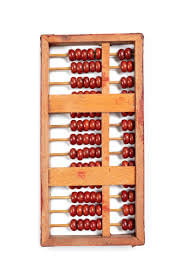
- The Chinese abacus, also known as the Suanpan, has a long history that dates back to ancient times, specifically to the Eastern Han dynasty around 190 Common Era. Since then, it has served as an essential tool for performing basic arithmetic operations and has been widely used in China to teach elementary school students speedy mental calculations.
- In the past, the Chinese abacus was a mandatory assessment for accountants and financial managers until 2004. However, its usage has become limited in modern times.
- The typical Suanpan is approximately twenty centimeters tall and features a frame made of wood or metal. It consists of two segments, namely the upper beads (heaven beads) and the lower beads (earth beads), which are divided by a horizontal rod known as the unit pointer.
- The upper segment contains two beads, while the lower segment contains five beads. The modern Chinese abacus follows the 4+1 beads model, where the rightmost bead represents the base value of 1, followed by 100, 1000, 10000, and so on as we move to the left.
2. The Soroban Abacus Tool
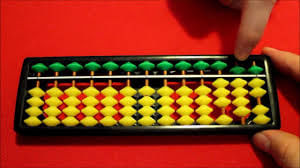
- The Japan abacus, commonly known as the Soroban abacus, draws its basic structure from the Chinese Suanpan abacus while taking inspiration for the number of beads from the Roman abacus. It was first introduced to Japan from China around the 14th century.
- The standard Soroban abacus typically consists of 13 rods, although arrangements with odd numbers ranging from 7, 9, 11, 13, 15, 17, and so on up to 31 or more are also seen. It is commonly crafted using materials such as wood, metal, and bamboo.
- The distinctive feature of the Soroban abacus, setting it apart from the Suanpan, lies in the arrangement of the beads. The upper segment of the rods contains only one bead, while the lower segment houses four beads within each rod.
- A standard Japanese abacus follows a ratio of 1 : 4. However, other Japanese abaci may have ratios of 2 : 5 or 3 : 5. In Japan, learning Anzan, mental arithmetic using visual imagery, often goes hand in hand with learning the abacus, as it is an integral part of mastering rapid calculation skills.
3. The Roman Abacus
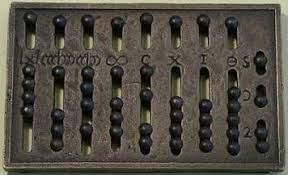
- Throughout history, Romans employed different tools to simplify calculations. They utilized methods such as counting pebbles and relying on human calculators.
- The Roman Abacus, introduced in the 11th century by Gerbert d'Aurillac (Pope Sylvester II), underwent subsequent modifications to enhance its portability.
- It transformed into a compact device featuring eight long grooves containing beads and tracks. This version is also known as the Wax abacus.
4. Sumerian Abacus
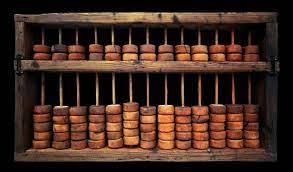
The Sumerian Abacus, believed to have been invented around 2700-2300 B.C., consisted of a single frame with multiple columns containing beads. These beads were arranged based on a system of 60 bases.
5. Indian Abacus Tool
 Ancient Indian scriptures mention terms like "ekanka" and "vartik," indicating that Indians have been utilizing tools for calculations since ancient times. In present-day India, the abacus holds significant importance in elementary education.
Ancient Indian scriptures mention terms like "ekanka" and "vartik," indicating that Indians have been utilizing tools for calculations since ancient times. In present-day India, the abacus holds significant importance in elementary education. - The Indian Abacus used today bears close resemblance to the abacus tools used in China and Japan. The standard abacus typically consists of 17 rods and is both easily accessible and portable.
6. Schoty or The Russian Abacus

- The Russian Abacus, commonly known as schoty or counting beads, is a highly versatile type of abacus. It was developed in the 17th century with the purpose of facilitating precise business transactions and currency calculations.
- The fundamental structure of the schoty consists of a frame made of either wood or metal. It features eleven rows and ten beads, with a distinctive characteristic found in the eighth row, which contains only four beads.
- Additionally, every fifth bead is colored differently from the rest. Unlike other abacus types, the Russian Abacus does not possess columns, and its beads are marked with varying colors.
7. Cranmer Abacus
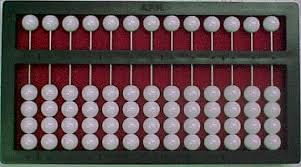
- In 1962, Terence V. Cranmer introduced the Cranmer abacus, which was specifically designed to assist visually impaired children and adults. This modern version of the Cranmer abacus drew inspiration from the soroban, a traditional Japanese abacus.
- The primary objective of the Cranmer abacus was to cater to the needs of visually impaired individuals, enabling them to perform various mathematical calculations, including addition, subtraction, multiplication, and division, much like a standard abacus.
- The Cranmer abacus features white beads that are equipped with a fabric backing, ensuring that the beads remain stationary in their positions. The parallel rods are securely embedded into a rectangular black frame, which is divided into two sections: the upper and lower sections. The upper section contains a single white bead, while the lower section accommodates four beads.
Which abacus do we use today around the world?
- The abacus serves as a fundamental tool for assisting children in learning arithmetic calculations.
- There are no set rules or guidelines specifying the specific tool to be used or the correct approach.
- In India, the commonly used abacus tool for teaching is the modern abacus, also known as the Japanese abacus.
|
52 videos|82 docs|3 tests
|

















